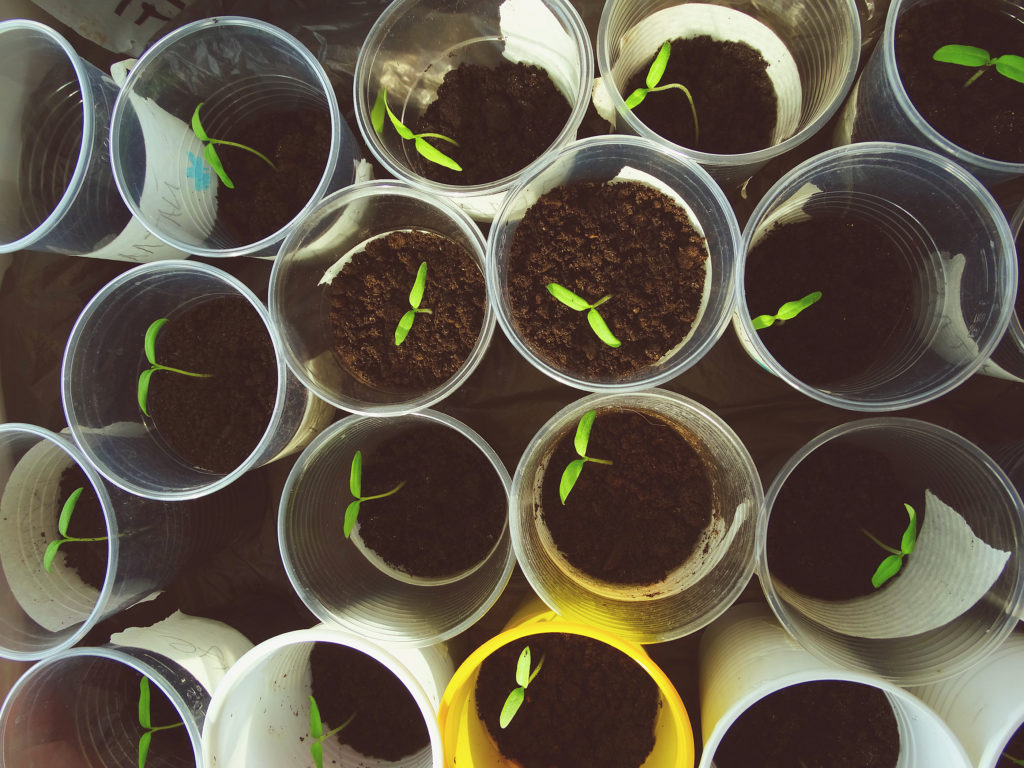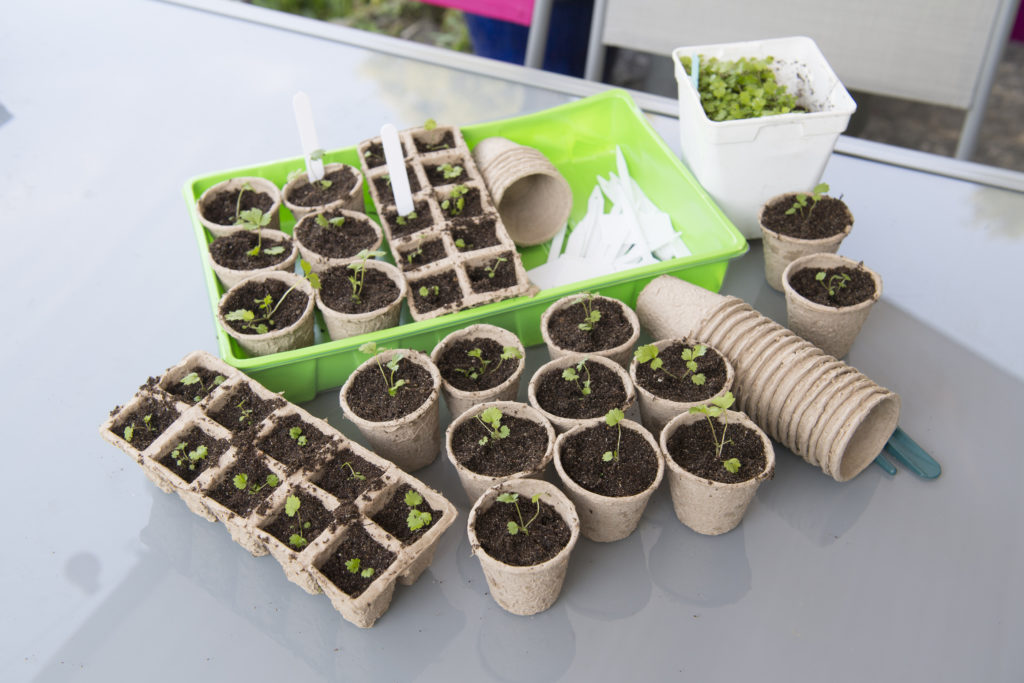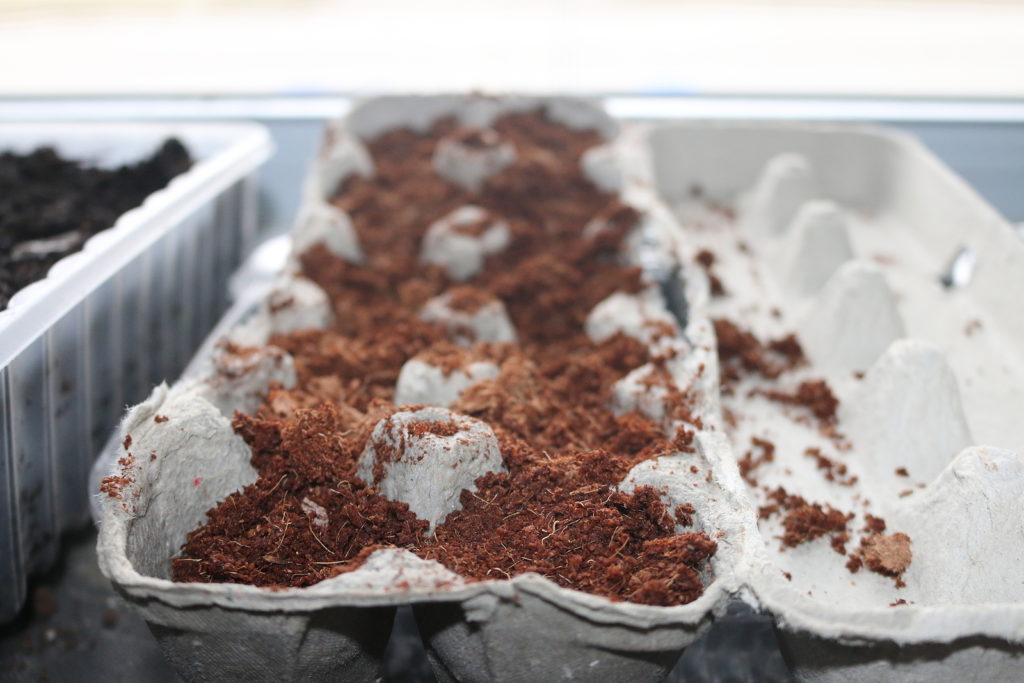
Starting seed in the garden can be challenging, especially early in the season. Garden soil either too cold or too wet are the chief obstacles to germination in late winter and early spring. The solution: start seeds indoors early in the season.
Vegetables that are the easiest to start indoors from seed are broccoli, Brussels sprouts, cabbage, cauliflower, leeks, lettuce, onions, peppers, and tomatoes. Flowers that are easy to start from seed include alyssum, cosmos, marigolds, Shasta daisies, and zinnias.
Good Products at Amazon for Seed Starting Success:
- Jump Start Germination Station w/Heat Mat Tray, 72-Cell Pack, Dome
- Espoma Seed Starting Mix
- 200 Count- Jiffy 7 Peat Soil Seed Starting Plugs
- Seed Starter Kit with Humidity Dome (120 Cells Total Tray)
- AgrobriteT5 Fluorescent, 2-Foot, Grow Light System

Basic Seed Starting Supplies Checklist
□ Containers: flats or individual containers at least 3 to 4 inches deep.
□ Seed-starting and potting mixes: finely ground aged compost and perlite will work for seed starting. Later you will need a potting mix: 1 part garden soil, 1 part perlite or builders’ sand; 1 part fine compost.
□ Lights: adjustable up and down fluorescent lights will do to keep plants growing.
□ Capillary mats placed under containers will wick up moisture to the seeds and seedlings.
□ Half-strength fertilizer to get seedlings growing: fish or seaweed fertilizer or compost tea.

February Seed Starting–the warmest regions first:
USDA Zone 10:
□ Prepare empty parts of the garden for planting.
□ Direct-sow cool-season vegetables.
□ Sow summer vegetables and tender herbs in the cold frame.
□ Plant asparagus and artichoke roots.
□ Plant grapes and figs.
□ Sow bachelor’s buttons, nasturtiums, and California poppies outdoors.
□ On mild days, prune berries, brambles, grapes, and fruit trees.
□ Soak potted citrus trees to flush out excess fertilizer salts.
□ Clean out pots and containers to be planted in spring.
USDA Zone 9:
□ Set out cabbage family transplants early this month: cabbage, broccoli, kale, and collards.
□ Direct sow seed of cool-season vegetables: beets, carrots, leaf lettuce, peas, and turnips by mid-month
□ Plant out asparagus and artichoke roots.
□ Sow summer vegetables and tender herbs in the cold frame: beans, cucumbers, sweet corn, and tender herbs such as dill, fennel, and basil.
□ Indoors keep tomato, pepper, and eggplant seedlings beneath bright lights.
□ Mulch potato plants.
□ Thin leafy greens in the garden and water regularly.
□ Side dress crops already in the garden with aged compost.
□ Soak potted citrus trees to flush out excess fertilizer salts.
□ Clean out pots and containers to be planted in spring.

USDA Zone 8:
□ Plant asparagus and artichoke roots when the soil can be worked.
□ Plant potatoes and mulch them well.
□ Plant onion sets in well-worked well-drained beds.
□ Late this month, direct sow, endive, lettuce, spinach, and other leafy greens in the garden.
□ Prepare planting beds for carrots and root crops; direct sow radishes if the ground can be worked.
□ Start tomatoes and peppers indoors; place flats or pots beneath bright lights as soon as they sprout.
□ Plant blackberries, blueberries, and strawberries.
□ Fertilize established fruit with aged compost.
□ Prune berries, brambles, grapes, and fruit trees. On mild days, apply dormant oil sprays.
□ Sow hardy annuals such as sweet peas outdoors.
□ Clean out pots and containers to be planted in spring.
USDA Zone 7:
□ Finish updating garden plans.
□ Turn under winter cover crops if the soil is dry enough to cultivate.
□ Spread ½ inch of compost over beds that you will plant soon.
□ Weed strawberries and place a row cover over the bed to encourage early bloom.
□ Start lettuce, cabbage, spinach, and early tomatoes indoors under lights.
□ Set seed potatoes in a warm place to encourage sprouting.
□ Harden off cabbage family seedlings outdoors in a cold frame; at the end of the month plant them in the garden beneath cloches.
□ Sow peas and parsley directly in the garden near the end of the month.
□ Set out onion sets when the soil can be worked.
□ On mild days, prune berries, brambles, grapes, and fruit trees. Also on mild days, check for over-wintering pests and apply dormant oil sprays.
□ Prune hybrid tea roses late in the month; also set out new roses as soon as the soil can be worked.
□ Clean out pots and containers to be planted in spring.
USDA Zone 6:
□ Finish updating garden plans; plan successions and crop rotations for this year’s garden.
□ Order new seeds. Be sure supplies are on hand for indoor seed-starting.
□ Test stored seeds for germination.
□ Sow cabbage family crops indoors beneath lights; start cabbage, cauliflower, and broccoli. Start celery, onions, leeks, and hardy herbs indoors beneath grow lights or fluorescent lights.
□ Prepare planting beds as soon as the soil has dried; prepare beds for peas, potatoes, and other early crops.
□ Sow sweet peas and Shirley poppies outdoors. Pot up dahlias that have begun to sprout.
□ Clean out pots and containers to be planted in spring.
□ On mild days, prune berries, brambles, grapes, fruit trees. Also on mild days, check for over-wintering pests; apply dormant oil sprays.
Good Products at Amazon for Raised Bed Growing
- Galvanized Raised Bed 8×3
- Cedar Raised Bed 4×8
- Elevated Cedar Planter 4×2
- Walk-In Greenhouse Tunnel 15x7x7
- Row Cover for Freeze Protection 10×30

USDA Zone 5:
□ Finish updating garden plans; plan successions and crop rotations for this year’s garden.
□ Order new seeds. Be sure supplies are on hand for indoor seed-starting.
□ Test stored seeds for germination.
□ Start celery, onions, leeks, and hardy herbs indoors beneath a grow light or fluorescent lights. Towards month’s end start early cabbage and cabbage family crops indoors.
□ Sow alpine strawberries indoors.
□ Outdoors cover compost and planting beds with black plastic to help them thaw.
□ Direct seed poppies and larkspur outdoors.
□ If the temperature goes above 40°F (4.4°C), prune apples, pears, and grapes. If temperatures are warmer than 40°F for at least twenty-four hours, apply dormant oil sprays.
□ Clean out pots and containers to be planted in spring.
USDA Zones 4 and 3:
□ Finish updating garden plans; plan successions and crop rotations for this year’s garden.
□ Order new seeds. Be sure supplies are on hand for indoor seed-starting.
□ Test stored seeds for germination.
□ Sow seeds of onions, chives, and cress indoors under lights.
□ Sow alpine strawberries indoors.
□ Late this month, sow indoors early cabbage, broccoli, cauliflower, and celery.
□ Prepare the cold frame for use next month.
□ Sow indoors pansies, violas, snapdragons, daisies, and hardy flowers.
□ Lightly trim damaged wood from mature apple trees, postpone heavy pruning for a few more weeks.
□ If the temperature rises above 40°F (4.4°C), prune apples, pears, and grapes. If temperatures are warmer than 40°F for at least twenty-four hours, apply dormant oil sprays.
□ Clean out pots and containers to be planted in spring.
Grow 80 vegetables and herbs from seed: KITCHEN GARDEN GROWERS’ GUIDE















